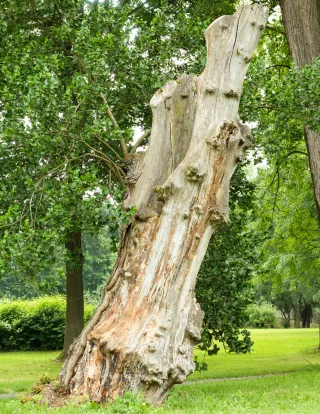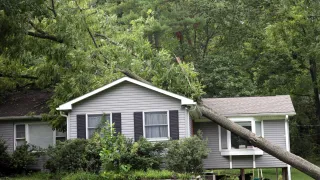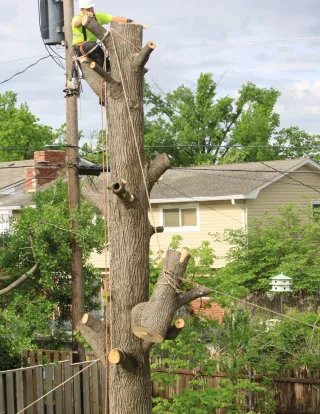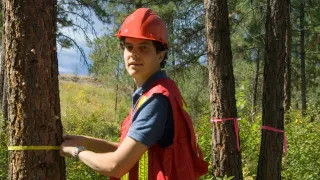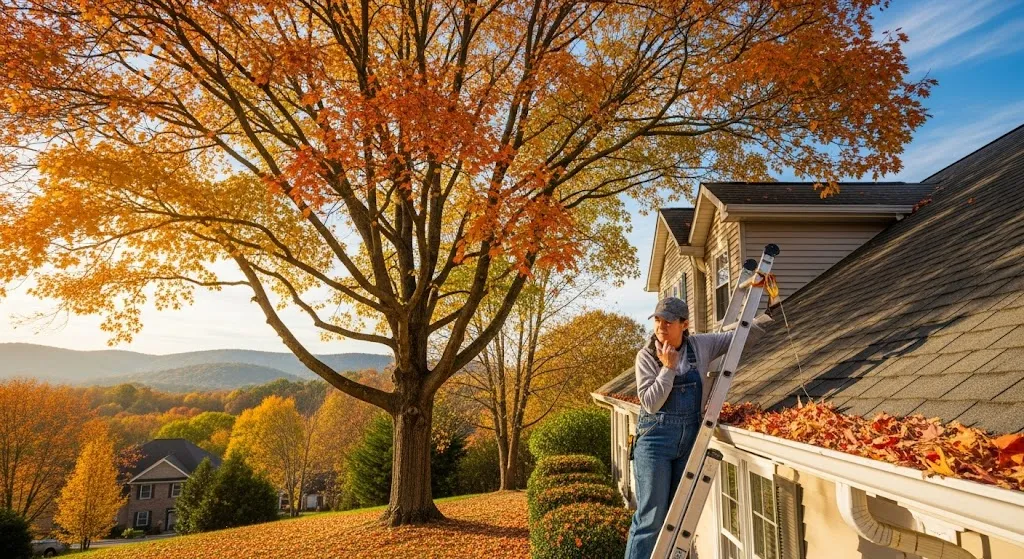
Gutter Problems? Your Trees Might Be the Real Culprit
Every fall, I get calls from homeowners frustrated with constantly clogged gutters. They've tried different guards, hired cleaning services multiple times a year, and still can't stay ahead of the problem. Often, the issue isn't the gutters themselves – it's the trees around the house that are creating impossible maintenance situations.
Understanding which trees cause gutter problems and why can help you make better decisions about tree management and save you ongoing headaches and costs.
How Trees Create Gutter Problems
Leaf volume is the obvious culprit, but it's not just about autumn leaf drop. Some trees shed leaves, twigs, flowers, fruits, and bark throughout the growing season.
Overhanging branches don't just drop debris directly into gutters – they also create pathways for debris from other areas to collect and concentrate in problem spots.
Root systems can affect drainage around your house foundation, making gutter overflow problems worse when they do occur.
Tree placement relative to prevailing winds affects how debris moves around your property and where it accumulates.
The Worst Offenders
Sweet gum trees are probably the #1 gutter nightmare. They drop spiky seed balls, leaves, and small branches almost year-round. The seed balls are particularly problematic because they don't break down quickly and can jam in downspouts.
Oak trees drop leaves, acorns, small twigs, and flowers at different times throughout the year. Large oaks can produce enormous volumes of debris, and oak leaves take longer to decompose than many other species.
Maple trees drop flowers in spring, seeds (helicopters) in early summer, and large volumes of leaves in fall. The seeds can be particularly problematic in gutters.
Pine trees shed needles year-round, and pine needles are notorious for creating dense mats in gutters that hold water and promote ice dam formation.
Bradford pears drop flowers, small branches, and leaves, plus they're prone to storm damage that creates additional debris.
Seasonal Timing of Problems
Spring brings flower and seed drop from many species, plus small twigs and branches from winter damage.
Summer can bring seed pods, small fruit, and leaf drop from stress or storm damage.
Fall is the obvious problem season with major leaf drop, but also fruit, nuts, and seed pod drop from various species.
Winter brings additional twig and small branch drop, especially during ice storms and high winds.
Some trees create problems year-round, making gutter maintenance a constant battle rather than a seasonal chore.
The Real Cost of Tree-Related Gutter Issues
Cleaning costs add up quickly when gutters need attention multiple times per year instead of once or twice.
Gutter damage from constant debris and cleaning can shorten gutter lifespan and require repairs or replacement sooner than normal.
Ice dam problems are often worse when gutters have debris that prevents proper drainage and creates areas where ice can form and build up.
Foundation and landscape damage from overflowing gutters can be expensive to repair and might not be covered by insurance if it's considered a maintenance issue.
Time and frustration – constantly dealing with gutter problems takes time and energy that most homeowners would rather spend elsewhere.
Strategic Tree Management Solutions
Selective branch removal can reduce the amount of debris falling directly into gutters without removing entire trees. Crown raising (removing lower branches) and selective pruning of overhanging branches can significantly reduce debris problems.
Timing matters for pruning – removing seed-producing branches before seed season, or pruning to reduce flower production, can be more effective than trying to clean up the mess afterward.
Sometimes tree removal makes sense when the ongoing cost and hassle of gutter problems outweigh the benefits of keeping a problematic tree.
Tree replacement with less problematic species can solve gutter issues while maintaining the benefits of having trees on your property.
Species Selection for New Plantings
If you're planting new trees, consider mature size and debris production in relation to your house and gutters:
Better choices for areas near houses:
Dogwoods (small, manageable debris)
Redbuds (small tree, limited debris)
Japanese maples (small, less problematic debris)
Crape myrtles (manageable size and debris)
Trees to avoid near gutters:
Sweet gums (year-round debris problems)
Large oaks (massive debris volume)
Pine trees (needle problems)
Bradford pears (messy and structurally weak)
Gutter Protection Systems
Gutter guards and covers can help with tree-related debris, but they're not magic solutions. Different systems work better for different types of debris, and some tree debris can overwhelm any protection system.
Mesh guards work well for large leaves but can be clogged by small debris like pine needles or small seeds.
Solid covers with slots handle most debris well but can be overwhelmed by heavy leaf fall or small debris that fits through the slots.
Brush-type inserts can handle various debris types but may need periodic cleaning and replacement.
No gutter protection system eliminates maintenance when you have heavy debris loads from nearby trees.
Maintenance Strategies That Work
More frequent, lighter cleaning is often more effective and safer than waiting for gutters to become completely clogged.
Seasonal timing – cleaning just before peak debris seasons (like before fall leaf drop) can prevent major clog problems.
Professional cleaning services may be worth the cost if you have difficult access or heavy debris loads, especially if you factor in the time and safety issues of doing it yourself.
Combining tree maintenance with gutter maintenance – scheduling both types of work strategically can be more efficient and cost-effective.
When Tree Removal Makes Sense
Trees that create ongoing, expensive gutter problems sometimes cost more to live with than to remove, especially if they don't provide significant benefits.
Diseased or declining trees that also cause gutter problems are often good candidates for removal.
Trees planted in poor locations relative to houses and gutters might be better removed and replanted elsewhere or replaced with more appropriate species.
Cost-benefit analysis – if annual gutter cleaning and repair costs approach the cost of tree removal, removal might make financial sense.
Professional Assessment
Tree professionals can evaluate which specific branches or trees are causing the most gutter problems and suggest targeted solutions.
Sometimes the solution isn't obvious – trees that seem like they shouldn't be causing problems might be contributing through indirect effects or specific debris types.
Combining tree assessment with gutter evaluation can help identify the most cost-effective solutions for your specific situation.
Professional tree work is often necessary for dealing with branches near power lines or for large-scale pruning projects.
Property Value Considerations
Mature trees generally increase property value, but trees that create ongoing maintenance problems can be a negative factor for potential buyers.
Well-maintained trees that don't cause problems are more valuable than neglected trees that create constant issues.
Strategic tree management that solves practical problems while maintaining landscape value is usually the best approach.
Good tree placement in landscape design prevents problems before they start.
Prevention for New Construction
Plan tree placement in relation to roof lines and gutter locations during initial landscaping.
Consider mature tree size and debris characteristics when selecting species for areas near houses.
Design gutters and drainage with existing or planned trees in mind.
Professional landscape design can help avoid tree-related gutter problems from the beginning.
The Long-Term Perspective
Tree problems often get worse over time as trees grow larger and produce more debris.
Early intervention through strategic pruning or tree management can prevent problems from becoming unmanageable.
Regular assessment of tree-gutter relationships helps you address developing problems before they become expensive.
Planning for tree maturity means thinking about what your landscape will look like and how it will function in 10-20 years, not just how it looks today.
The Bottom Line
Trees and gutters don't have to be enemies, but they do require strategic management to coexist successfully. Understanding which trees cause problems and why helps you make better decisions about tree maintenance, gutter protection, and overall property management.
Sometimes the best solution is tree management, sometimes it's better gutter systems, and sometimes it's a combination of both. The key is identifying what's actually causing your specific problems and addressing those root causes rather than just treating symptoms.
If you're dealing with constant gutter problems and suspect your trees might be the culprit, give us a call or text at (423) 443-4533. We can help assess which trees are causing issues and discuss solutions that work for your property and budget – whether that's strategic pruning, selective removal, or replanting with better species choices.


